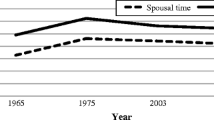Abstract
During the last decade more and more time-use data were gathered on a household level in stead of on an individual level. The time-use information of all members of the household provides much more insight in research fields that until now largely used data gathered at the individual level. One of these research fields is the study of quality of life, based on the (quality) time partners within a household spend together which in turn is often linked to studying the associations between the amount of time spent together and relationship satisfaction. The amount of face-to-face spousal interaction is considered to be critically important for marital quality and is assumed to be violated within dual-earner couples, especially those with women working long hours. In this contribution we analyze the time-use of couples in the Belgian Time Use Surveys of 1999 and 2005. We identify which activities couples do together and which they do apart, and what household characteristics predict couples’ together time. Working times in general seem the most decisive factor influencing the amount of together time. The increased labor market participation of women, on the other hand, seems not to be so much a threat for the time a couple spends together.

Similar content being viewed by others
References
Berger, P., & Kellner, H. (1964). Marriage and the construction of reality. An exercise in the microsociology of knowledge. Diogenes, 12(46), 1–23.
Calasanti, T. M., & Bailey, C. A. (1991). Gender inequality and the division of household labor in the United States and Sweden: A socialist-feminist approach. Social Problems, 38(1), 34–51.
Daly, K. (1996). Families & time. Keeping pace in a hurried culture. Thousand Oaks: Sage.
Evans, J. M., Lippoldt, D. C., & Marianna, P. (2001). Trends in working hours in OECD countries, OECD labour market and social policy occasional papers, No. 45. Paris: OECD.
Gager, C. T., & Sanchez, L. (2003). Two as one? Couples’ perceptions of time spent together, marital quality, and the risk of divorce. Journal of Family Issues, 24(1), 21–50.
Glorieux, I., Mestdag, I., & Minnen, J. (2008a). Technisch verslag Time&Budget (Technical report Time&Budget), Brussels: Vrije Universiteit Brussel, Department of Sociology, Research Group TOR.
Glorieux, I., Mestdag, I., & Minnen, J. (2008b). The coming of the 24-hour society? Changing work schedules in Belgium between 1966 and 1999. Time & Society, 17(1), 63–83.
Guldner, G. T., & Swensen, C. H. (1995). Time spent together and relationship quality: Long-distance relationships as a test case. Journal of Social and Personal Relationships, 12(2), 313–320.
Hamermesh, D. S. (2002). Timing, togetherness and time windfalls. Journal of Population Economics, 15(4), 601–623.
Huysmans, F. (1996). Social time and media use. Communications, The European Journal of Communication Research, 21(4), 405–419.
Kalmijn, M., & Bernasco, W. (2001). Joint and separated lifestyles in couple relationships. Journal of Marriage and Family, 63(3), 639–654.
Kingston, P. W., & Nock, S. L. (1987). Time together among dual-earner couples. American Sociological Review, 52(3), 391–400.
Presser, H. B. (2000). Nonstandard work schedules and marital instability. Journal of Marriage and the Family, 62, 93–110.
Schwartz, L.K., Herz, D., & Frazis, H. (2002). Measuring intrahousehold allocation of time: Response to Anne E. Winkler, Monthly Labor Review, 125, February, 53–59.
Spitze, G., & South, S. J. (1985). Women’s employment, time expenditure, and divorce. Journal of Family Issues, 6, 307–329.
Van Wissen, L. J. (1991). A model of household interactions in activity patterns, Working Paper, No. 15, The University of California at Berkeley, The University of California Transportation Center.
Author information
Authors and Affiliations
Corresponding author
Additional information
This research was funded by FWO-Flanders (project number G.0.267.08.N.10).
Rights and permissions
About this article
Cite this article
Glorieux, I., Minnen, J. & van Tienoven, T.P. Spouse “Together Time”: Quality Time Within the Household. Soc Indic Res 101, 281–287 (2011). https://doi.org/10.1007/s11205-010-9648-x
Accepted:
Published:
Issue Date:
DOI: https://doi.org/10.1007/s11205-010-9648-x




